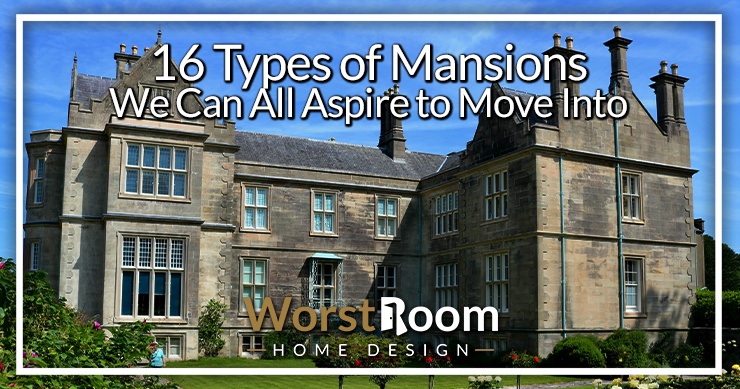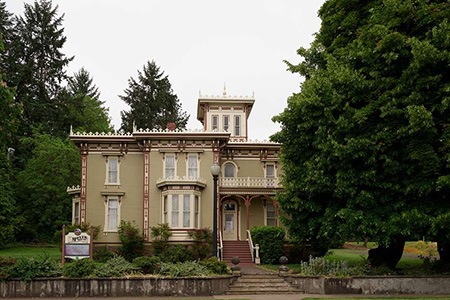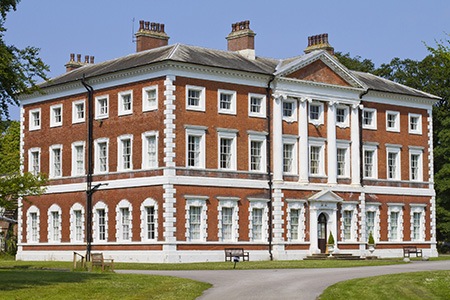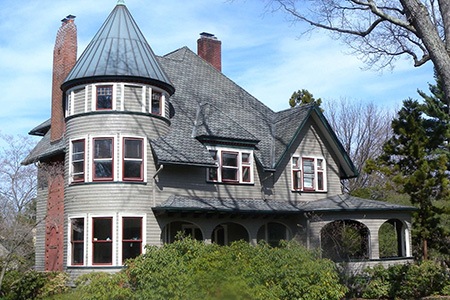16 Types of Mansions We Can All Aspire to Move Into
Author: Rick Worst | Editor: Omar Alonso
Review & Research: Jen Worst & Chris Miller

Depending on where you live and where you come from, a mansion could mean something different, but the generally accepted definition is of a gigantic, fancy house... You know, the swanky types of mansions that today’s celebrities and yesteryear’s nobility call home, with all kinds of unnecessary luxuries thrown in.
16 Types of Mansions
While most of us may never actually get to live in a mansion, it can be quite interesting to know about (and secretly covet) the different types of mansions that do exist. Once you settle on the different styles of mansions you want to aspire to, check out the mega mansions that the most wealthy people on the earth have bought or had built.
Craftsman Mansions

Born in the times of the Industrial Revolution, the Craftsman mansion was the brainchild of Gustave Stickley, founder of then-popular The Craftsman, a magazine that heavily promoted both Stickley’s products as well as the philosophy behind the famed American Arts and Crafts movement (of which he was a key propagator).
In the magazine were laid out several simple, plain building plans and styles that anybody could build or have built. The University of Wisconsin-Madison has them all digitally archived if you want to look through them.
As these houses grew in popularity, so did their sizes, eventually going from Craftsman homes to Craftsman mansions, with the latter featuring eaves, fireplaces, window seats, porches, thick types of columns, neutral color palettes, and the use of classy materials like stone, stucco, and wood.
Farmhouse Mansions

It’s easy to write off anything to do with farmhouses as rustic and basic, but farmhouse mansion styles do exist.
Many designers are finding ways to infuse contemporary elements into the traditional farmhouse structure, so you have sleek lines set against barn-style roofs, industrial fixtures on wooden floors, and chic fireplaces with wrought-iron decorations.
Of course, there are still traditional farmhouse mansion types, which are large, wooden houses featuring multiple types of rooms, porches, windows, and a barn, typically sitting on a huge plot of farmland.
Victorian Mansions

A product of the Victorian era (hence, the name), Victorian mansions featured opulent rooms with intricate details, especially in the reception, living, and bedrooms, and tiled bathrooms spread out over two or three stories. They look very much like medieval types of castles or like gothic cathedrals.
In their heydays, the standout feature of these mansions was the presence of running water—hitherto unheard of for most folks. Since they were modeled after the European monarchy’s royal abodes, these mansions almost always included ballrooms and vast halls for entertaining.
While there are hardly any genuine Victorian-era types of mansions left in the United States, several folks today are going the Victorian route with their mansion, retaining many of the original characteristics while also adding contemporary features.
Cape Cod Mansions

First built in 17th-century New England, Cape Cod mansions got their name from a former Yale University president and their inspiration from the quaint thatched cottages that dot British country.
These styles of mansions were born when England’s Puritan carpenters carried the cottage style from their homeland and adapted it to New England’s conditions.
Cape Cod mansions, like their British cousins, feature huge chimneys (to better stay warm in the northeast’s unforgiving winters), a single floor, plenty of windows (again, to let in as much light and warmth as possible), a broad layout, and of course, the signature feature—steeply sloping roofs.
You can find two types of Cape Cod mansions—the original mansions and the modern versions (further divided into three-quarter Cape, the full Cape, and the half Cape).
Mediterranean Mansions

These mansions shot to fame in the first half of the 20th century, inspired by the gorgeous hacienda-like residences of the Mediterranean, with their multi-hued tiles, ample types of arches, solid wooden doors, intricate designs on the grills and metalwork (especially in balconies, doors, and windows), and the signature red roof and tiling.
Italianate Mansions

If you weren’t alternating between sobbing and laughing through Call Me by Your Name, you were probably lusting after the gorgeous Italian villa that Elio’s family inhabited in the movie.
Turns out that the craze for Italian-style villas hit the United States a couple of centuries earlier, with Italian-style mansions springing up everywhere in the country in the late 19th century. In fact, they became so popular across the States that people started calling them American-style mansions.
These types of mansions retained several features from the original plan, such as sloping roofs, doorways, elaborate overhanging eaves, multiple levels, a double-doored main entrance, a dome that sits just over the roof, and elongated, narrow windows with curved tops.
McMansions

For those who want a mansion but aren’t too particular about quality, there are McMansions. These are mass-produced abodes that feature all the characteristics and amenities that define a mansion, but each McMansion will look exactly the same as the other—these houses don’t have individual characters or unique features.
Therefore, they were a great option for upper and middle-class families who wanted a fantastic-looking, luxurious house that elevated their social standing, even if these houses were built cookie-cutter style. They won't have any types of fountains outside, as they aren't that nice, but wish to be.
Additionally, these mansions weren’t designed by architects, which meant that there were tons of mismatched, disjointed features both inside and outside the structure. Often, there’s a lot of compromise on the quality of such homes (inferior materials and quick, careless construction), so long as the curb appeal is great.
Lastly, these mansions often feature small plots of land, to house a lawn or a swimming pool, instead of the sprawling gardens and manicured lawns that you would see in actual mansions. To make it worse, this plot and its amenities are usually shared with a neighbor. Of all the different mansion styles, you could argue these don't even qualify.
Classical Mansions

These are the original modern mansions, constructed with the finest material and labor available back in the early 1900s. Today, many of these mansion types have been accorded a historically significant status, such as Austin’s The Façade House and New Jersey’s Shadow Lawn Mansion.
Neoclassical Mansions

Neoclassical mansions had their share of the limelight in the early 1900s when people went gaga over these Greek and Roman-inspired structures. Evidence of their popularity lies in several official buildings and the many neoclassical mansions sprawled across the country.
Some of the most common features of this mansion style are the flat or domed roofs, elaborate columns, impressive size, and symmetrical shapes and decoration.
There are three subtypes of neoclassical mansions—the temple (resembling ancient Greek temples, such as the British Museum), the Palladian styles (resembling Roman temples, such as the Capitol), and the classic block (with multiple amenities, levels, bedrooms, bathrooms, windows, and arches, as found in many government buildings).
English Country Mansions

If you’re thinking of the Bridgertons or Downton Abbey, you got that right. These types of mansions are the quintessential manors of the English countryside, housing some of the country’s noblest (and richest).
Surrounded by acres of grounds, these houses usually featured around 12 bathrooms and bedrooms, with a large staff to tend to every small aspect of the house’s upkeep throughout the year, though the owners only retreated to these houses seasonally or to throw lavish parties (spending the rest of their time traveling or in London).
English country mansions feature multiple windows and floors and wide arches, while heavily favoring symmetry. Many mansions eventually fell into disuse and disrepair with the shift to an industrial society and the diminishing importance and favor accorded to the English aristocracy.
Tudor Mansions

Inspired by the medieval Tudor houses of England, Tudor mansions feature thin windows, intricate woodwork, and high roofs. These different types of houses are often seen in animated fantasy stories, built as gingerbread houses, and other related children's activities due to their classic look and feel.
Colonial Mansions

The name for the huge, palatial houses that the colonizers built, colonial styles of mansions are some of the most common and most distinguishable houses in the United States, a mix of Spanish, English, Portuguese, and European influences.
These types of mansions and houses first made an appearance in the latter half of the 17th century, retaining popularity until the 20th century.
There are several types of colonial mansions, namely the British, Spanish, Dutch, French, German, Revival, and modern-day colonial mansions. Each style carries features of the architectural styles of the native country, adapted to conditions in the United States.
Georgian Mansions

Georgian mansions were heavily influenced by Italy’s Renaissance period, first built in 18th-century New England and remaining popular for much of the century.
These were minimally embellished mansions with many shuttered windows, a symmetrical layout, and plain brick construction. These houses were originally homes to tobacco farmers and plantation owners.
With passing time, many builders started adding embellishments to these mansions, such as impressive gardens, huge columns around the main door, and outhouses, while retaining the layout and other key features.
French Normandy Mansions

These are castle-like mansion styles that feature arched doorways, rounded towers, and red-tiled roofs. They became especially popular when they were converted into hospitals to house wounded soldiers returning from the First World War.
Shingle-Style Mansions

Featuring wooden shingles (as the name implies), these mansion types also feature wide porticos and asymmetrical exteriors that are well-placed to present a harmonious façade.
Mid-Century Modern Mansions

If you’re familiar with the Harvard Five (an amazing group of architects), you’re probably already familiar with the last of the different mansion styles on our list, mid-century modern mansions. This group of architects created beautiful Bauhaus-inspired mansions around the country, characterized by many windows, flat levels, and an open floor plan.
Types of Mansions for Which We Aspire
There’s no doubt that mansions are extremely beautiful structures and the stuff of dreams for most of us. However, many mansions are open to public tours today, so even if you can’t live in one, you can always visit one and have a little bit of fun trying to identify what types of mansions they are.



